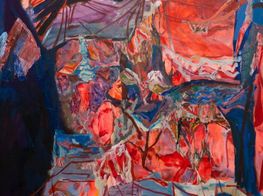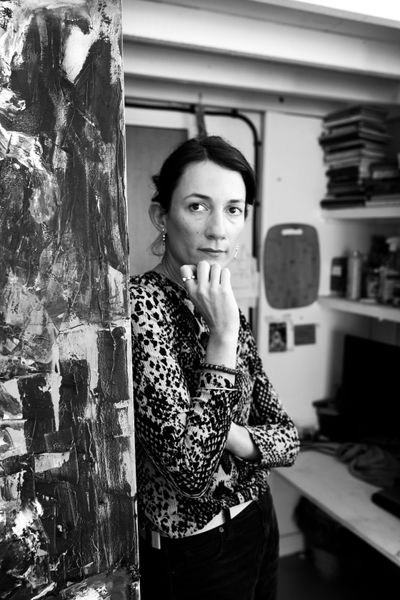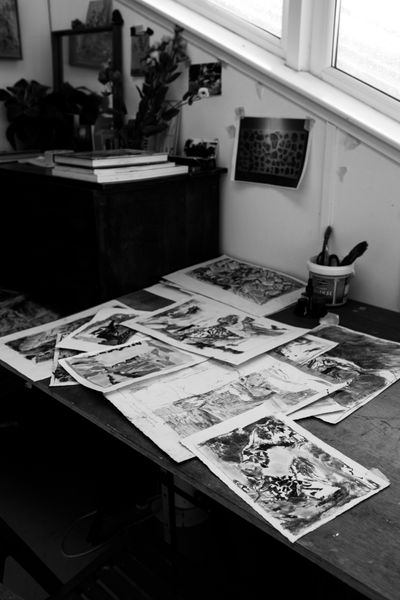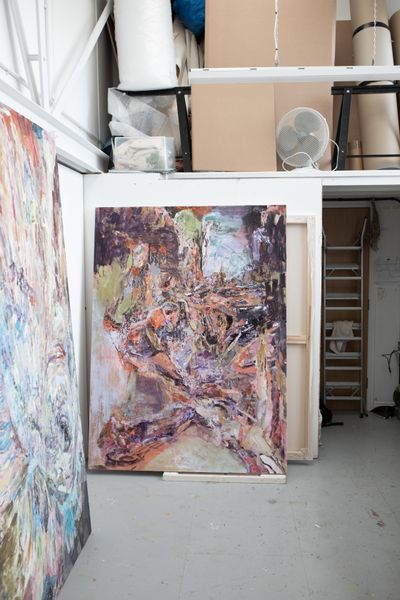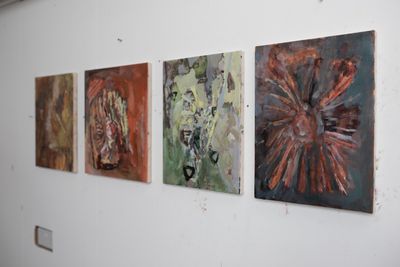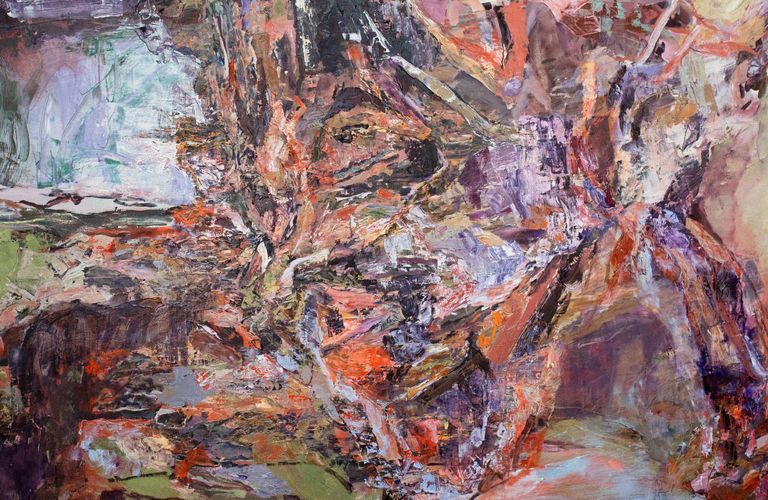
Entanglements of iridescent colour and expressive layers of impasto permeate Francesca Mollett's abstract landscapes. Using abstraction as a tool to explore the complexities of liminal space, the Bristol-born artist's latest paintings emerge from a craving to capture the reaction and reflection of light on surface.
Since graduating from The Royal College of Art, London, in 2020, Mollett has received extensive interest in her work, particularly in London with a lineup of solos at galleries including Taymour Grahne Projects (2022), Informality Gallery (2021), and a group show at The Approach (2021).
Earlier this year, GRIMM Gallery announced her representation with a solo exhibition scheduled in their flagship Amsterdam gallery in 2023.
Ahead of her inclusion in Sabrina at Sim Smith (19 November–17 December 2022)—a group exhibition of contemporary abstract expressionist female and non-binary painters, curated by Russell Tovey—Mollett discusses the latest developments in her practice.
Can you tell me a little about a typical day in the studio?
I normally build up to painting, so I don't go to the studio and paint immediately. Depending on what stage I am at with my work will determine my studio day. If I've just started a painting, I will go to the studio early to read and lay out different drawings. I like to avoid interruptions when I'm working, which is why I love painting in the evening and staying late in the studio without distraction.
How do you start a painting? Do you make preparatory sketches or is it the product of intuition and improvisation? Do you use any source material?
When I start working on a painting, I initially draw with charcoal on canvas which can take some time. I believe underdrawing is a significant part of the painting process, as it provides a specific weight and structure for me to play with.
Afterwards, I tend to work on the floor to create a fluid form where the watery acrylic painting becomes suggestive of new events. I work over wet and dry layers of oil and acrylic paint, using a palette knife or paintbrush to manipulate the different layers of paint in the canvas to create a depth of texture.
I am interested in making non-representational work, as what I love about painting is the invention that happens in the gap of translating something real into paint, and how I can explore that in passages of mark-making. Each composition originates from a specific image that I have in mind, and develops into something more abstract when I look at the painting for answers about how to react to it.
The decisions I make are often determined by the movement of marks within the painting. About halfway through the process, I leave the image behind and follow ideas within the painting.
When I paint, I am trying to create something that becomes like an image of looking—elements can appear almost recognisable and then dissolve. I use a palette knife in my painting process because it allows me to entangle part of the paintings back around on themselves. I'm able to pick up one part of the painting and deposit it somewhere else. This technique's cyclical nature also has the effect of appearing like a collage that hints at the multiplicity of perception that we experience.
You attended The Royal Drawing School, London, between your BA and MA. Did that foundation in technical draftsmanship lay the basis for your contemporary painting practice today?
Initially, when I was at The Royal Drawing School I wanted to make figurative paintings. The course immediately followed my BA and it felt like a natural way to continue making art in London.
However, while there, I became exposed to so many different kinds of drawing and subjects. I would visit the National Gallery to draw from historical paintings, such as Piero della Francesca, Titian, or Cezanne.
Drawing outside on location, exploring space, and absorbing qualities of atmosphere, influenced the development of my practice and how I respond to particular places. I became more interested in the handling of materials and form than making a representational image. In fact, my time at The Royal Drawing School led to my interest in abstraction.
I read that you have curated a number of shows. When you are working towards a show do you have one overarching theme that informs each work or do you approach each work as a single entity?
When I graduated from The Royal Drawing School, I co-ran and founded a project space and set of artist studios in South London called 'The Benevolent Association of Excellent Solutions' between 2015 and 2016. I also co-curated with two friends a number of exhibitions and artist-led projects including Smoke gets in your eye at rural BAES near Lewes in 2018 and Dust sheet embroidered snow at Project Gallery in Arundel in 2019.
For exhibitions, a continual subject for me is light and how that can shatter or react on a surface. I'm also interested in themes that explore the different forms and textures derived from landscape.
I am fascinated by particular places. For example, in South London there is a railway bridge tunnel where the local community have created a display of real and imagined fossils that encouraged me to explore new forms and think about deep time. My upcoming show in February 2023 at Friends Indeed Gallery in San Francisco will draw on this material.
I also draw inspiration from texts. Earlier this year, I had an exhibition at the Baert Gallery in Los Angeles titled Spiral Walking (7 May–18 June 2022). For the show, I found a relationship between the way I thought about painting, and Fanny Howe's concept of the spiral walker, from her 2003 essay Bewilderment.
As with a number of artists nowadays, you've received quite a bit of attention since graduating from your MA in 2020. How do you shut out the noise and focus on your work?
It can be quite intense for artists. I've built up my practice and carried on progressively after graduating. Now, it's a little more intense but that's okay as I'm excited everyday about where my practice is going.
When I am in the studio making things, I am extremely focused on the work in hand. I have the same sway of emotions I've always had between being exhilarated by one painting and completely dissatisfied with another. All this hasn't changed—progress isn't linear and the fluidity going on in a practice is something that will always occur at whatever stage in your career.
My representation with GRIMM Gallery has come at a really good time and I am so pleased to be with such a supportive and thoughtful team. Ultimately, your gallery is there to help guide you and protect you in a way.
What is next for you?
In November, I'm showing work in the group show Sabrina (19 November–17 December) at Sim Smith, curated by Russell Tovey. It includes work by artists Gillian Ayres, Tracey Emin, Pam Evelyn, Caroline Jackson, Katy Moran, Victoria Morton, Daisy Parris, Hayley Tompkins, and Michaela Yearwood-Dan. It's going to be a really great show.
In February, I'll be having a solo exhibition with Friends Indeed Gallery and following that I'm looking forward to my first solo show with GRIMM Gallery in Amsterdam in May 2023.—[O]
Main image: Francesca Mollett. Courtesy Ocula. Photo: William Waterworth.

